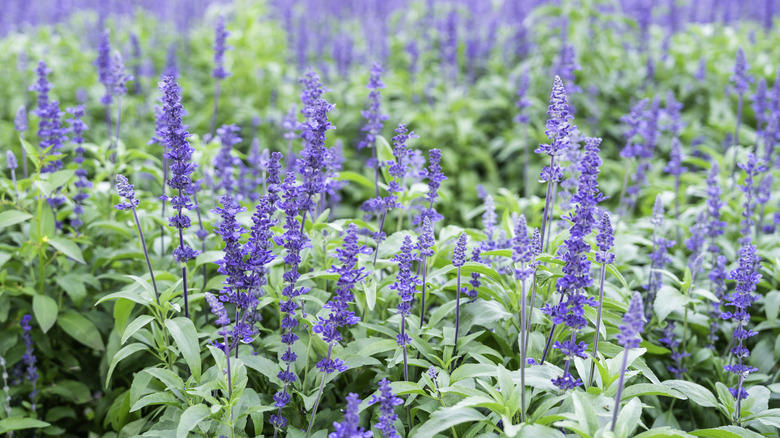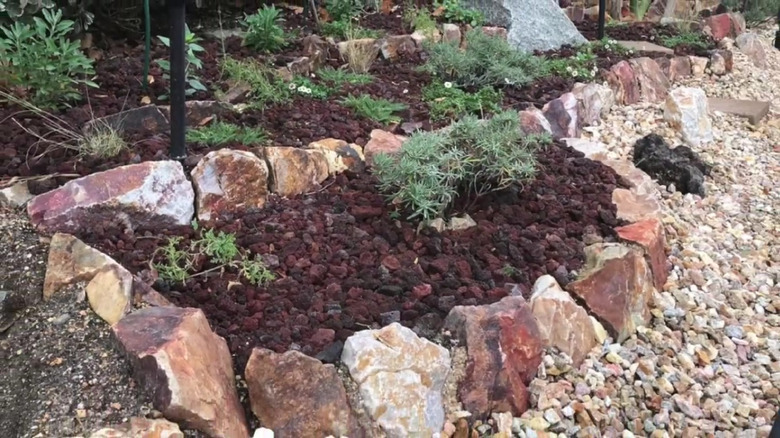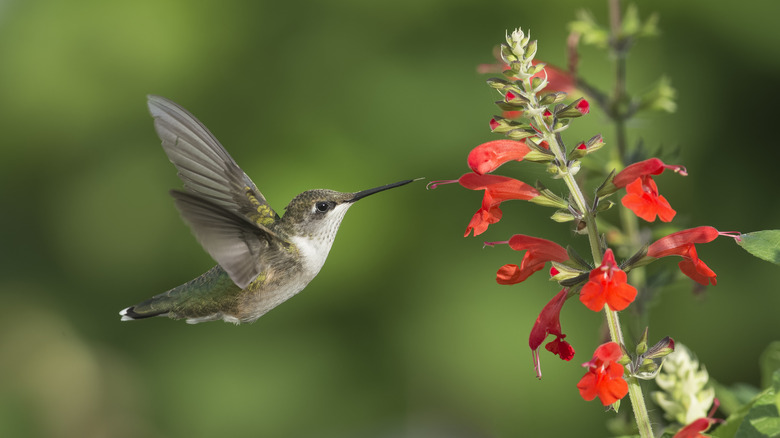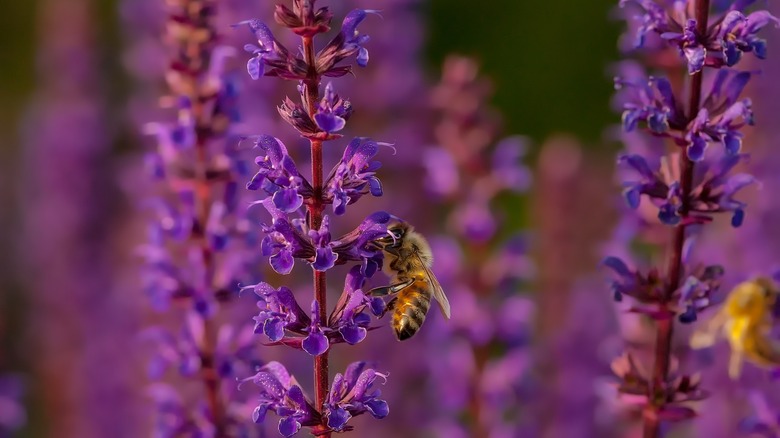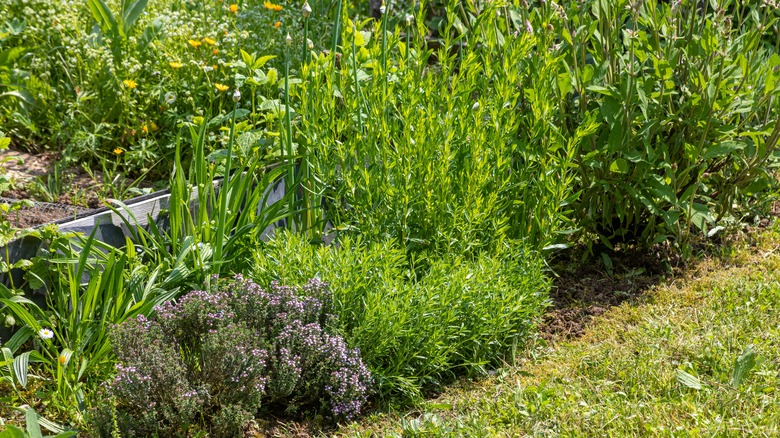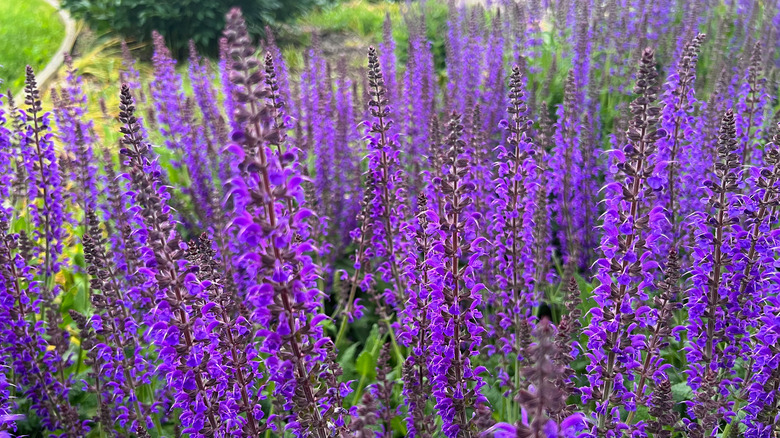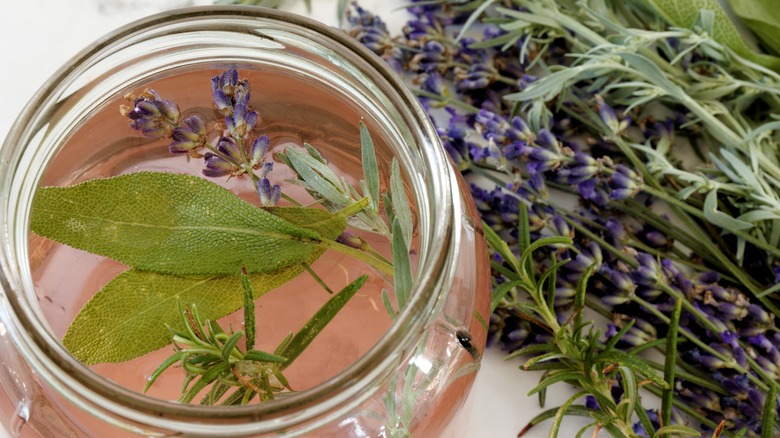Genius Ways To Use Sage Around Your Home And Garden You'll Wish You Knew Sooner
When you think of sage, sausages, pork chops, and turkey stuffing are probably the first things that come to mind. Or, if you're an avid gardener, you may picture vibrant, low-maintenance, fragrant flowering plants adorning your garden beds. But sage has so much more to offer in the home and garden beyond these well-known uses.
Sage (Salvia spp.) is a broad genus of plants in the mint family. Some varieties are ornamental, but many can serve a number of brilliant functions both out in your garden and inside the house — many of which you probably didn't know about. For instance, did you know that sage is an aesthetically pleasing alternative to erosion control blankets? And that, apart from keeping the topsoil layers intact, it can also draw in numerous desirable creatures, like hummingbirds, bees, and butterflies. This omnipotent plant doesn't stop there — it's also an effective pest repellent, weed killer, odor regulator, and antimicrobial agent. All of these characteristics have been backed by science. Below, we'll walk you through the nitty-gritty of each genius way you can utilize sage to make your home and garden a better place.
Sage helps control erosion in a sloped garden
Is your hillside yard suffering from erosion? Erosion is a natural process in which the ground gets blown or washed away by wind or rainwater. This process affects hillside landscapes the most, as their sloped surface facilitates and accelerates the downward flow of water. If you have a sloped yard, erosion can strip away significant portions of its topsoil over time — unless you take steps to control it. And what better way to prevent erosion on a sloped lawn than by using a living erosion control mat like sage?
White sage (Salvia apiana) and San Luis purple sage (Salvia leucophylla) are excellent erosion control plants if you live in warmer climates, as they thrive in USDA hardiness zones 7 to 11 and 8 to 10, respectively. Meanwhile, California sage (Salvia columbariae) is hardy in USDA zones 6 to 9, which makes it a better candidate for cooler climates. That said, most varieties of Salvia are considered excellent erosion control plants because their shallow roots help hold the top two feet of soil together in the face of destabilizing natural forces. You can even protect your sloped garden with common sage (Salvia officinalis) since it's a ground cover species that forms a mat with dense roots that keep the topsoil layer from getting washed away. Common sage tolerates a range of climatic conditions since it's hardy in zones 4 through 10.
Use sage to attract hummingbirds to the yard
If you take delight in seeing hummingbirds zip around your garden plants in search of nectar, you'll be happy to know that a number of sage varieties can be used to attract hummingbirds. Salvias are particularly appealing to these little feathered creatures because of their inflorescence. Hummingbirds have acute color vision, which they use to select flowers for feeding. And salvia blooms are vibrantly colored, a quality that helps hummingbirds identify them as bearers of sweet nectar. Moreover, sages have elongated, cylindrical blooms that fit like a glove over hummingbirds' thin, long beaks; inside the flowers, they find a treasure trove of sugary nectar. Fortunately for hummingbirds, sage flowers are generally inaccessible to birds that can't hover (only hummingbirds can) since their stalks are too fragile to support the weight of a bird. So, in many ways, sages and hummingbirds are a match made in heaven.
In addition to Salvia officinalis, you can plant a whole host of different Salvia varieties to entice hummingbirds to your garden. If you live in the warm, southern reaches of the nation, try the scarlet sage (Salvia coccinea). This sage species is a hummingbird favorite and the only native sage to have blood-red blooms. It thrives as a perennial in USDA zones 9 to 10, but you can grow it as an annual in colder regions. The Blue Anise Sage (Salvia guaranitica) is another warmth-loving variety that flourishes in zones 8 through 10 but makes for a splendid annual hummingbird magnet in cooler zones. Being hardy in zones 4 to 10, the common sage is a go-to variety across much of the contiguous U.S. (and, yes, hummingbirds love it, too).
Sage will draw pollinators to the garden
Hummingbirds aren't the only creatures sage will invite to your garden. Several Salvia varieties are also known to attract other pollinators. For example, Blue sage (Savlia azurea var. grandiflora) serves as a powerful draw for bees and butterflies while attracting other pollinating insects to a lesser extent. A key feature that makes it attractive to these creatures is the shape of its flowers. The blooms' lower lip is substantially larger than the upper one, so the arriving insects can use it as a platform on which to land and go after the plant's nectar. As they feed, the insects' weight presses on the plant's stamens, setting off a mechanism that drenches them with pollen. Apart from encouraging bees and butterflies to grace your garden with their presence, Salvia azurea also adds a touch of blue color to your collection of ornamental plants — one that lasts into the fall. The Blue sage is native to the southeastern U.S. but will flourish in USDA zones 5 through 9.
Meanwhile, if you're mostly interested in attracting bees but keeping smaller insects at bay, consider planting the white sage (Salvia apiana). The structure of white sage's flower chokes off nectar access to all but the largest insects — and bees are among the only insects that can enter into a mutual symbiotic relationship with this sage. The epithet apiana in this plant's botanical name (which means bee in Latin) reflects this tendency. White sage is a California native but can grow as a perennial in USDA zones 7 through 11.
Sage can be a pest-repellent indoors and in the garden
While sage is irresistible to many desirable creatures such as hummingbirds and pollinating insects, it's loathsome in equal measure to a number of garden pests. Behind sage's ability to keep pests out of the garden is the odor that its leaves produce. Sure, we may find sage aromatic — hence the many culinary uses of this herb — but insects and snails generally cannot stand to be around it if planted in large amounts.
For example, the foliage of common sage is known to ward off rust carrot flies, which generally attack carrots but also feast on other vegetables, such as parsnips and celery. Likewise, you can grow a border of Salvia officinalis around your cabbage, kale, tomato, and soybean plants to protect them against cabbage worms. Finally, there's evidence that the common sage effectively repels flea beetles, which can wreak havoc on your potato, eggplant, turnip, melon, and spinach crops. When using live sage to prevent pest infestations, avoid planting it next to cucumbers, as the two make poor companion plants. Also, note that you can't rely on sage alone to keep these pests out of your garden (and they may have their own pest issues, although they are rare, such as spider mites and spittle bugs). One or two sage plants also won't be potent enough to ward off pests — while exact numbers are unknown, the more you plant, the better the results. To make your pest defenses as robust as possible, take the time to research other ways to repel bugs naturally and use them in conjunction with sage borders.
Using living plants isn't the only pest control option sage affords. You can also dry sage leaves and burn them — say, when entertaining on your patio or dining in the garden. The resulting smoke might be able to act as a deterrent against flies and mosquitoes. However, there is no scientific proof backing this up, only anecdotal evidence. So make sure to have tried-and-true options on hand in case it doesn't work, like using fans to keep them away from your space.
Growing sage is an effective way to suppress weeds
Like many other ground cover species, sage is a plant that can help keep weeds from taking over your garden. Ground covers like sage prevent weeds from taking over the garden by, essentially, beating them to it. They outcompete the weed seedlings for sunlight, water, and nutrients so that the latter have almost no chance to become established and spread. Some unwanted plants may still poke their heads through, but with the surrounding sage usurping all the necessities of life, they'll stay frail as they wait for you to pluck them.
Apart from simply starving weeds of essentials like water, light, and nutrition, salvia plants seem to have another, more sinister card up their sleeve. According to a study published in the "Current Bioactive Compounds Journal," the California sage (Salvia leucophylla) has allelopathic properties. Allelopathy is a natural process some plants use to chemically subdue other plants growing nearby, and the California sage uses this process to specifically target grasses and forbs (i.e., herbaceous flowering plants). So, while the California sage may not be a great companion for your wildflower patch, at least it will keep weeds away from where you grow it. Other studies have shown that Pineapple sage (Salvia elegans) and Munz's sage (Salvia munzii) also contain allelopathic chemicals in their essential oils.
Use sage to control odors in your home
Common sage has an earthy, sweet fragrance that's reminiscent of camphor. This very scent makes the plant useful in applications like cooking, pest deterrence, and, unsurprisingly, odor control at home. Sage lends itself perfectly to cover up offensive odors and infuse your spaces with its natural, pleasant fragrance.
A myriad of different causes can contribute to unpleasant smells in the home. Something as mundane as a seafood dinner or as disturbing as a dead opossum in the crawl space could easily send you running outdoors. Believe it or not, you can eliminate — or at least mitigate — many of these noxious odors by burning sage in your home. Its potent, pleasant smell will help cover up the foul one.
Even if you're not experiencing odor issues in the house, there's a good case for using sage as an aromatherapy tool that elevates your olfactory experience. An easy way to bring Salvia's distinct fragrance indoors is to make sachets and stuff them with its dried leaves. There are plenty of ways to make the sachets. However, if you're not keen on sewing, you can use bonding tape and an iron to fuse small sheets of fabric together at the edges before filling the pouches with dried sage and sealing the top in the same manner. You can leave these sachets in your drawers or linen cabinets.
Make a sage-infused cleaning solution with vinegar
If you're not a fan of wiping your cooking surfaces down with chemical cleaners, a natural, non-toxic sage-based alternative may be worth exploring. A study published in "LWT – Food Science and Technology" explored the antimicrobial effects of Salvia officinalis. During the study, researchers tested essential oils made from common sage on various food-borne pathogens and found that sage oil is incredibly effective at inhibiting bacterial growth. Given its potency as an antibacterial agent, there's good reason to use the plant's oils for disinfecting surfaces.
A good way to make a multi-faceted, natural cleaner is to use sage to infuse vinegar. Here's how. Start by pouring two cups of white vinegar with water into a glass jar. Then, crush fresh sage leaves with your fingers until you can smell their aroma. Finally, throw the crushed leaves into the vinegar, close the jar, and allow the mixture to infuse for at least half a month. Alternatively, instead of adding fresh sage leaves, you can pour a few dozen drops of sage essential oil into the jar. For greater potency, you can reinforce the solution with your choice of cinnamon, eucalyptus, lemon, tea tree, or orange essential oils. Using this unexpected natural cleaner is straightforward. You can transfer the infused liquid into a spray bottle, then lightly mist the surface you're working on and wipe it clean with a towel.
